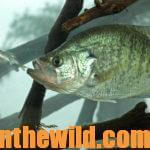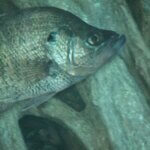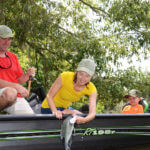Editor’s Note: This fall there’s been almost never-before very-high temperatures in the 90+ range. Where I live near Birmingham, Alabama, we’ve had 6 weeks of 95+ temperatures from late August through the first part of October. So, crappie fishermen must use summertime tactics to catch October crappie across much of the South. In other sections of the country, anglers will catch crappie with fall strategies. With 4 feet of snow falling in the U.S. Northwest the first week of October, some anglers must use winter methods to catch crappie there. This week, we’ll look at catching crappie now. Today’s crappie anglers are catching more and bigger crappie than ever before by going deep for crappie, which takes planning, close observation and special lure techniques for warm-weather crappie.
“I’d been bass fishing all summer when I began noticing schools of fish on the old creek channels and river channels where I fished,” says Lanny Deal of Eufaula, Alabama. “I assumed the schools of fish were crappie, because I never could get them to take my bass baits. One day, I decided to try and catch a mess of crappie. I ran the creek channels using my Humminbird depth finder (https://www.humminbird.com/), and when I located a school, I buoyed them off. I took my cane pole and set the cork at the depth where I saw the crappie on the flasher. When I dropped-in the minnow, the cork stood up and then sank, and I pulled-in a crappie. I caught 10 or 12 crappie before they stopped biting. Once I learned this technique, I was able to catch crappie all year on the creek channels.
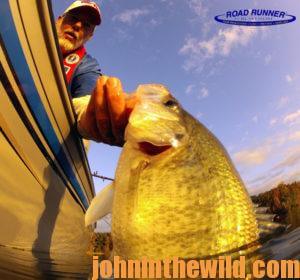
DCIM100GOPRO
“Now I try to find two or three schools of crappie, buoy them all off and then move from one school to the next and continue to catch all the crappie I want. My Humminbird depth finder allows me to catch plenty of big crappie all summer and in warm weather in open water. Depth finders will locate crappie, and just as importantly, they will locate deep cover where crappie hold, even if the flasher doesn’t show them.”
“I don’t try to see crappie on my depth finder,” Elbert Parker, another longtime crappie fisherman, explains. “If I can find old stumps and brush on the edge of a river or a creek channel with my depth finder, I know the crappie will be there. The crappie often will be so far in or under the cover that they won’t show-up on a depth finder. I’ve discovered that if I fish that submerged cover, I’ll catch crappie. I fish for crappie with jigs, tight-lining the jigs and then allowing them to sink-down and swim just above the cover. Oftentimes I’ll get hung-up in the structure and break-off. But if you’re not losing jigs, you’re not fishing in the right place to catch crappie. As for the importance of my depth finder, I would sooner be caught on the lake without my pants than without my depth finder,”
Crappie will relate to structure, and one of the best ways to find the crappie is to locate structure. But not all schools of crappie stay on structure all the time. As a matter of fact, there may be as many schools of roaming crappie to be caught as there are structure-oriented crappie. These roaming schools of crappie aren’t dependable every day, since they’re often on the move all day. Although some anglers use their depth finders to find the roving crappie, other anglers troll for them.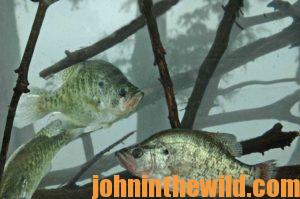
“I use six rods to find the rovers,” Billy Thomas, an avid crappie fisherman, says. “I’ll troll six-different-colored 1/16-ounce jigs at six-different depths, until I locate the crappie. Depending on the time of year, I’ll set my lines to hold about 6- to 12-feet deep. Once I determine the depth at which the crappie are holding, I’ll raise or lower the lines. Then all the lines will troll at the same depth.
“One important factor when tight-line trolling for crappie is the pound-test line you use. I prefer 4-pound-test Berkley Trilene XL line (http://www.berkley-fishing.com/). The more-limp and the smaller the line, the easier the line can knife through the water. By using smaller line, yourline doesn’t bow as much from the force of the moving water. I also troll very slowly. I try to move as slowly as the boat can go when the trolling motor is set on slow. Oftentimes I’ll cut the motor off to slow-down the speed of the boat.
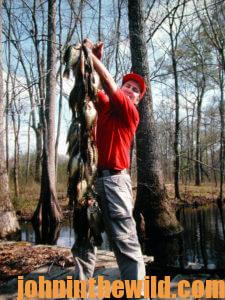 “The areas I’ve found to be the most consistent for producing crappie in warm weather are the mouths of creeks and the edges of old creek channels and river channels. Not all the crappie will be holding on bottom structure. They often move in and out of creeks and up and down ledges. Once I find the rovers, I’ll troll back and forth through them or cast to the school until it moves. Then I attempt to locate the school by trolling again.”
“The areas I’ve found to be the most consistent for producing crappie in warm weather are the mouths of creeks and the edges of old creek channels and river channels. Not all the crappie will be holding on bottom structure. They often move in and out of creeks and up and down ledges. Once I find the rovers, I’ll troll back and forth through them or cast to the school until it moves. Then I attempt to locate the school by trolling again.”
Maintaining a tight line at a certain depth is often a problem for some anglers. However, there’s an easy remedy and one that can cause a lot more action on your jig. “The little thumb-sized cork that minnow fishermen use easily will float a 1/16-ounce jig,” longtime crappie fisherman Gordon Elkins mentions. “By setting the line at the depth you want to fish with the cork, you ensure that your jig stays where you want to troll. With the cork, the angler also has the option of fishing as close to or as far away from the boat as he prefers. The pulsing action the cork gives the jig as it comes through the water makes the jig appear more lifelike. Although I utilize this trolling method to find crappie, I use my minnows and cane poles to catch the most and the biggest crappie out of the school in warm weather once I locate it. You can find more crappie by trolling jigs than by fishing minnows. Too, I can catch more crappie on a minnow than a jig.”
To learn more about crappie fishing, check out John E. Phillips’ brand-new book, “Crappie: The Year-Round River Fisherman’s Bible” at https://amzn.to/2mxWIt4, available in Kindle and print now and by January, 2020 available in Audible.
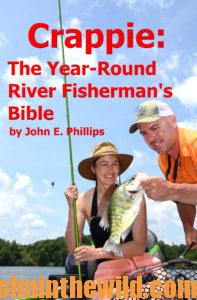
Tomorrow: Fishing Big Baits for Warm Weather Crappie




